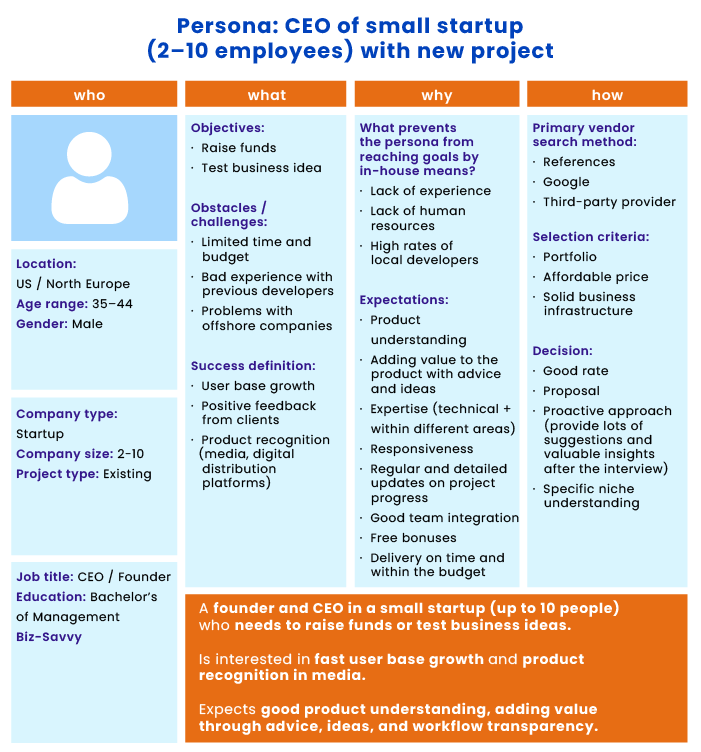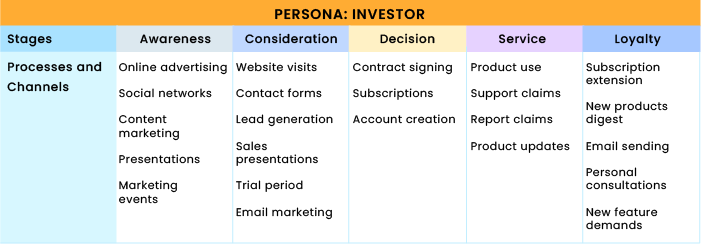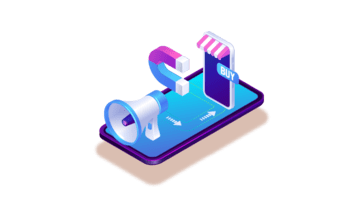-
Product Management
Software Testing
Technology Consulting
-
Multi-Vendor Marketplace
Online StoreCreate an online store with unique design and features at minimal cost using our MarketAge solutionCustom MarketplaceGet a unique, scalable, and cost-effective online marketplace with minimum time to marketTelemedicine SoftwareGet a cost-efficient, HIPAA-compliant telemedicine solution tailored to your facility's requirementsChat AppGet a customizable chat solution to connect users across multiple apps and platformsCustom Booking SystemImprove your business operations and expand to new markets with our appointment booking solutionVideo ConferencingAdjust our video conferencing solution for your business needsFor EnterpriseScale, automate, and improve business processes in your enterprise with our custom software solutionsFor StartupsTurn your startup ideas into viable, value-driven, and commercially successful software solutions -
-
- Case Studies
- Blog
How to Create a Customer Journey Map
Understanding the customer journey is crucial for creating great products. Having a clear picture of customers’ goals, and reasons for making buying decisions, marketers can influence sales, gain customer loyalty, and create a positive brand image.
A customer journey map can be made using many different approaches and templates. Its final view depends on the business model. For startup owners, the choice of strategy might get complicated. Especially when it concerns B2B companies, where the word “customer” refers to multiple actors performing different tasks for a common goal.
What is a customer journey map?
A customer journey map (CJM) visualizes a customer’s path from awareness of a product or service to its continuous use. It lets stakeholders see all points of a customer’s interaction with the product, detect pains and weaknesses at each stage of interaction, and find solutions to them.
Visually, a customer journey map may take various forms. Typically it is a horizontal matrix that includes such parameters as the buying process, user actions and emotions, user pain points, and solutions to those pain points.

Why create a customer journey map?
As a startup owner, it’s vital to create a customer journey map and keep it up to date when your product enters the market. If you visualize stages and touchpoints of the customer journey, it will be easy to see the flaws of your current business model.
Apart from the obvious advantages, there are many unobvious perks of using a customer journey map. With a CJM, you will:
Get a better understanding of your customers’ experience
Knowing each key event on your customer journey, you will be able to see the end-to-end experience of your target audience and be more empathic about customers’ pains. Once you realize what a customer needs to be happy each step of the way, you will be able to create a great product. Many businesspeople take the customer journey themselves to see how their vision differs from reality.
Create a unified vision of the customer within your company
With a customer journey map, the customer becomes more real. If the team can imagine the customer as a person, it’s easier to design problem solutions and cure the customer’s pains.
A unified vision of the customer journey will help all stakeholders be on the same page and work together toward common goals. In addition, such a view will improve the teams’ interactions and cross-functional processes.
Identify the customer interaction cycle
The customer relationship begins when a prospective customer recognizes your product’s existence. When you analyze each customer interaction and the full customer journey, you will identify gaps that need attention. This will let you identify and eliminate the obstacles your customers encounter.
Adjust your strategy to your customers’ demands
A customer journey map is a living entity where the customer is the driver of change. This tool will help your company be flexible and transform your product strategy according to customers’ needs. By keeping an up-to-date CJM, your team will be able to identify necessary changes in interaction with your audience and give customers what they want.
Boost sales and brand awareness
With a clear understanding of your customer journey, you will:
-
Raise awareness of your brand
When you analyze gaps in the interaction cycle, you can create an up-to-date marketing strategy to make your brand more visible to the target audience. As a result, the sales funnel will open up and bring more prospective clients.
-
Boost sales
Awareness of your customer journey can drastically improve the quality of your service from the customer’s first interaction through continuous use of your product. If you satisfy all customer needs and service expectations, customers will make buying decisions faster.
-
Retain customers
Customers doubt their buying decisions when they don’t get what they need. Does your company lose clients even though the product itself is competitive? The customer journey is probably not as perfect as the service you offer. Once you analyze why customers leave with the help of a customer journey map, many flaws will become evident. And, what’s important, you will be able to mitigate them.
-
Increase brand loyalty
Customer journey analysis has the power to improve the user experience on every level. Once your existing customers see positive changes, their satisfaction with your brand will grow and encourage them to stick with your solutions.
If used properly, a CJM will take your business to the next level. The main point is to make it as precise as possible and consider the specifics of your business model.
B2C and B2B customer journey map: what’s the difference?
Customer journey mapping can be tricky because the journey itself is rarely linear. The number of actors within one journey may vary, and it frequently depends on the specifics of the business.
For the business-to-consumer (B2C) business model, it’s much easier to identify the key points of customer interaction because the customer is one person. In other words, only one person interacts with your brand and performs tasks to achieve a goal.
In a B2B customer journey map, there’s usually a set of actors who make decisions and interact with the product according to their roles. Each actor is part of the customer communication in this case, and these actors must be included in the customer journey.
For example, in an enterprise company, the end user rarely buys a product. Instead, following the demand of their teammates, the team leader asks the CEO to buy a specific software. The CEO approves this purchase, lawyers study terms and conditions of product use, accountants organize the payment, and linear employees use it. All people mentioned are actors, while a customer for the seller of this software is simply an enterprise company.
Customer journey map creation guide

Every business decides on the most convenient way to create a representative customer journey map. No matter how you create a CJM, though, there are some typical stages of customer journey mapping. Follow these steps to discover your customers’ experience.
Step 1: Collect data
Before you create a customer journey map, you need to investigate the user experience your product offers here and now. Inform your team about your investigation so they can give you helpful insights.
Once you get statistics about your customer, you should conduct various marketing activities such as:
- Web analytics
- Customer interviews
- Customer surveys
- Competitor analysis
- Customer observations
Web analysis will show you what your clients do on your website, what they look for, which challenges they face, and why they leave. For example, maybe a form is too long and demands too many actions to complete a purchase, or maybe the website navigation is not intuitive enough to go to the next step. Pay attention to any repetitive patterns to understand what stops your users from proceeding with intended action.
Customer interviews will help you build a persona (we’ll talk about this later) and get to know your customer better. To get relevant information, conduct multiple interviews with customers and detect common pain points, challenges, and interaction traits. Also, make notes on emotions when customers describe the product and the actions they take. Sometimes, one disappointed sigh means more than a thousand flattering words.
Customer surveys are relatively easy to conduct. Invite your customers to take a survey via all communication channels you use: email, your website, social media, etc. Remember that surveys should include closed and open questions. Closed questions will help you measure customer satisfaction and get precise information, while open questions will let customers freely share their opinions. Also, include questions about competitors because it might disclose the companies you are competing with and don’t know about.
Customer observation is another great market research technique. It can be disguised or non-disguised. Disguised market research means you observe the customer interact with your product without the customer knowing. During non-disguised customer observation, you ask customers to perform actions directly. Observation research will let you analyze customer behavior and get a first-hand view of the customer journey.
Competitor analysis is crucial, especially if the competition is intense. Try analyzing your direct and indirect competitors’ user experiences to compare them to your own. This will let you see why some customers tend to choose a competitor’s solution and highlight the flaws you need to eliminate in your product.
After you gather information, you will be able to build a precise customer journey map. Also, this information will let you formulate a hypothesis on how to improve the customer experience.
Step 2: Define your persona
Based on the data you’ve gathered, create your persona. The persona is a fictional character: a collective personification of your clients with a clear motivation, goals, and background.
To be systematic, use the Who-What-Why-How matrix. This approach lets you see relevant descriptions of your customer from the point of view of your business.

WHO covers the demographic characteristic of your persona. It includes:
- Location
- Age range
- Gender
- Education
- Occupation and position in the company they work in
- Skills and preferences
Pro tip: For easier categorization, marketers name personas and add pictures to make them more realistic. If your project has multiple personas, it will be more convenient to say which product feature is essential for Paul and which obstacles are a stopper for Jane.
WHAT is your persona’s motivation. It shows which problems your persona wants to solve with your product and what a successful solution looks like. Consider describing:
- Clear objectives: what do they want to achieve?
- Obstacles and challenges they face on their way to achieving their goals
- Success definition and their desired result if they come to you to solve their problem
WHY will give you a sufficient description of why this persona needs your solution to achieve their goals. It lists:
- Reasons why they need your product and why they can’t achieve their goals without external help
- Expectations from your product or service
HOW is a description of the persona’s path to your product. It includes:
- Search methods and how they look for solutions to their problems
- Selection criteria (which aspects they pay attention to when they consider different solutions)
- Decision motivators (which factors influence their decision)
Once you’ve described all these points, create a unified one-page document to see the complete picture. After that, you can formulate the statement: A *WHO* who needs *WHAT* expects *WHY* by *HOW*.
For a cinema visitor persona, for example, your statement might look like this: “Jaden, an art school student and passionate cinema lover, needs to entertain himself after his studies. He expects to buy cinema tickets for a reasonable price, doesn’t want to wait too long for the showing, and hopes that the movies being screened will meet his interests. So he searches the web for cinemas nearby.”
Step 3: Identify customer journey stages

Customer journey stages represent the status of a customer's interaction with your company. This interaction starts from realizing the customer’s needs and ends with continuous use of the product that satisfies these needs. Consider listing the stages in this order:
-
Awareness
At this stage, customers realize their pains. As a result, they express interest in finding a solution to their problem and investigating market offers.
-
Consideration
Customers evaluate specific products and services, compare them, and interact with sellers. At the consideration stage, customers estimate the benefits of your product and its affordability.
-
Decision
This is the stage when customers commit to a specific solution, justifying their reasons for purchase. It’s important to remember that the purchase itself is not the end of the interaction with your company, as many tend to think.
-
Service
After customers commit to your product, they get an impression of its performance and customer service. This is the stage of choice validation when customers realize they made a right or wrong decision.
-
Loyalty
If the service stage meets no obstacles, customers start expressing interest in your company’s other products and services. Furthermore, a satisfied client becomes an unofficial ambassador for your brand.

Of course, the stages may vary from one industry to another. You may add necessary stages to highlight or simplify this scheme by removing the levels you find irrelevant. The primary purpose of this step is to understand the stages of interaction.
Step 4: Detect customer goals
When you create a customer journey map, your initial objective is to align your business with customers’ needs. To do that, you need to understand what clients want at each stage of the customer journey. Define customer goals for the stages you’ve discovered:
-
Awareness stage goals
Find out if there are any solutions to the customer’s problem on the market.
-
Consideration stage goals
Understand which affordable solution fits the customer’s needs.
-
Decision stage goals
Commit to a specific solution and start using it to achieve the customer’s initial goal.
-
Service stage goals
Analyze profits from the product, discover all its opportunities, and evaluate the service.
-
Loyalty stage goals
Continue using the product that covers the customer’s needs; discover other products and services by the same brand.

After setting customer goals for each stage, you may dive into precise interaction points.
Step 5: Define touchpoints
A touchpoint is an encounter between a business and a customer. Touchpoints happen via all communications channels, including paid ads, social media, third-party mentions, and any other means of customer involvement.
Each stage of the customer journey includes its own touchpoints. Before adding them to your customer journey map, divide them into several groups:
-
Actions
Detect all actions your customer executes to achieve their goals. For example, if the goal is to compare solutions, the customer will usually visit websites, start free trials, or leave their contact information for your sales department.
-
Emotions
Emotion is a driving force for decision-making. Track your clients’ emotions to understand their satisfaction with the product and determine its weaknesses. For example, if a customer is often frustrated or exhausted when they visit your website, it may indicate that the user interface has flaws. If you eliminate these flaws, the emotions of your customers will positively change.
-
Pain points and obstacles
At each stage of the journey, customers have a pain they want you to cure. When you fill out your customer journey map, you will have to address such pain points to improve your product. For instance, a common pain point at the awareness stage can be a lack of information. In this case, your goal will be to educate your potential customers, give clear answers to their questions, and make this information accessible.

Step 6: Add processes and channels
Once you have all the customer information listed on your map, add the processes and channels you use to interact with your customer at each stage. There are several types of interactions:
-
Linear
This type of interaction goes from point A to point B. At the decision stage, it would be signing the contract, getting payment, and creating a user account. Remember that every process must have a responsible team member who tracks the actions.
-
Non-linear
A non-linear process is not as precise as a linear process. In this case, you and your customer know point A and point B, but the actions to get from A to B may vary.
-
Cyclic
A cyclic interaction is a repetitive chain of actions that is typical for the service stage. For example, if you offer a subscription, contact with your customer will happen once a billing period.
-
Bi-directional
Sometimes, a linear process may lead to the creation of new tasks. In this case, customers can go back to the initial interaction or execute their actions simultaneously.
-
Branch-like
For a B2B customer journey map, each actor may have specific channels or be involved in different processes. As a result, the operations will be branch-like, with all actors having their own channels and tasks.

Step 7: Detect problems and create solutions
When you see the full picture of your customer journey, you may start adjusting your business to your customer’s needs. Explore the obstacles your customer encounters at each stage of the journey and suggest ideas that can eliminate them. Take them as opportunities for growth via customer satisfaction, address the problems your customers might face, and use your CJM to improve your service.

How to use a customer journey map?

A customer journey map is a tool, not a goal. After creating it, you need to adapt your business strategy to customer demand. These are the actions you should take:
Estimate resources
The customer journey map will highlight the customer’s needs and show what you need to offer a positive customer experience. Audit your existing inventory and define the features/technologies/resources your business lacks for enabling customers to achieve their goals.
Implement improvements
Here is a list of ideas you should bring to life in your customer journey map. These ideas should become tasks for your team. To get this process going, you should:
-
Assign a person in charge
This can be more than one person, but everyone in the team should be aware of who is leading this task.
-
Define exact steps
Set precise tasks and sub-tasks. Assignees should understand the initial objective of these tasks and be aware of what the team wants to achieve.
-
Prioritize tasks and set deadlines
The improvement itself may be in vain if it’s done too late. Remember that speed of delivery is one of the key points of customer satisfaction. When you analyze customer pains, identify the blockers that need to be eliminated first and give them the highest priority.
-
Draw a process flow
Once you have prioritized tasks, you will see the process order. Don’t try to do everything at once. Otherwise, you will bump into errors and misunderstandings from both your team and customers.
Estimate results and adjust your strategy
Keep tracking data changes and conclude what worked and what didn’t. Carefully analyze which solutions solved the customer’s problem and which made it worse or gave no result at all. This will let you see your plan’s flaws so you can take immediate action in case something goes wrong.
Update your customer journey map
Business development and the customer journey happen simultaneously. Every action brings changes and transforms your customer journey map. So when you check your hypothesis on improving your customer experience, you should continuously update your map to have a real-time vision of your relations with customers.
CJM is key
A customer journey map is a great real-time customer development tool. The magic of it is that it lets you get to know your customers better. It’s much easier to make an excellent product for a person you know and, what’s more important, love. As long as you give love to your customers, you will get love in return.
FAQ
-
A customer journey map (CJM) is a visual tool that shows a customer’s path from awareness of a product or service to its continuous use.
-
The perks of creating a CJM are multiple, especially for those who plan a product release. With thorough research of a customer journey, you can adjust your strategy according to your customers' needs, create a unified vision of your customer within your team, identify customer interaction cycle, and facilitate a successful release of your product on the market.
-
The strategy may vary in its details for each specific industry. Anyway, a unified approach is such: gathering information, creating a persona, identifying customer journey stages, defining customer goals, detecting touchpoints, adding processes and channels, and ideating solutions.










